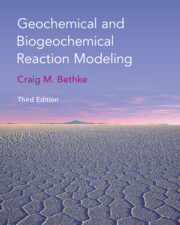Book contents
- Frontmatter
- Dedication
- Contents
- Preface
- Preface to Second Edition
- Preface to First Edition
- A Note About Software
- 1 Introduction
- 2 Modeling Overview
- PART I EQUILIBRIUM IN NATURAL WATERS
- PART II REACTION PROCESSES
- 14 Mass Transfer
- 15 Polythermal, Fixed, and Sliding Paths
- 16 Geochemical Buffers
- 17 Kinetics of Dissolution and Precipitation
- 18 Redox Kinetics
- 19 Microbial Kinetics
- 20 Association and Dissociation Kinetics
- 21 Kinetics of Gas Transfer
- 22 Stable Isotopes
- 23 Transport in Flowing Groundwater
- 24 Reactive Transport
- 25 Stagnant Zones
- PART III APPLIED REACTION MODELING
- Appendix A Sources of Modeling Software
- Appendix B Evaluating the HMW Activity Model
- Appendix C Minerals in the LLNL Database
- Appendix D Nonlinear Rate Laws
- References
- Index
21 - Kinetics of Gas Transfer
from PART II - REACTION PROCESSES
Published online by Cambridge University Press: 09 December 2021
- Frontmatter
- Dedication
- Contents
- Preface
- Preface to Second Edition
- Preface to First Edition
- A Note About Software
- 1 Introduction
- 2 Modeling Overview
- PART I EQUILIBRIUM IN NATURAL WATERS
- PART II REACTION PROCESSES
- 14 Mass Transfer
- 15 Polythermal, Fixed, and Sliding Paths
- 16 Geochemical Buffers
- 17 Kinetics of Dissolution and Precipitation
- 18 Redox Kinetics
- 19 Microbial Kinetics
- 20 Association and Dissociation Kinetics
- 21 Kinetics of Gas Transfer
- 22 Stable Isotopes
- 23 Transport in Flowing Groundwater
- 24 Reactive Transport
- 25 Stagnant Zones
- PART III APPLIED REACTION MODELING
- Appendix A Sources of Modeling Software
- Appendix B Evaluating the HMW Activity Model
- Appendix C Minerals in the LLNL Database
- Appendix D Nonlinear Rate Laws
- References
- Index
Summary
The movement of gas species across the air–water interface is a central aspect of biogeochemical cycling and plays a critical role in controlling not only the composition of the atmosphere, but the chemistry of aquatic and marine systems. This chapter shows how kinetic rate laws describing the transfer of gas species into and out of aqueous solution can be integrated into multicomponent chemical reaction models and shows a fully worked calculation, using carbon dioxide efflux from a biologically active lake as an example.
Keywords
- Type
- Chapter
- Information
- Geochemical and Biogeochemical Reaction Modeling , pp. 255 - 260Publisher: Cambridge University PressPrint publication year: 2022

